This post was written for the Centre of Alternative Technology's student blog, reporting on the latest module of the MSc Sustainability and Adaptation courses at CAT (I'm studying on the MSc Sustainability and Adaptation in the Built Environment course). The original blog can be found here: http://blog.cat.org.uk/2015/03/26/getting-to-grips-with-thermal-comfort/ along with some great blogs by other students on the MSc and Architecture Part II (Professional Diploma) courses, and CAT's own excellent blog covering a wide range of sustainability issues.
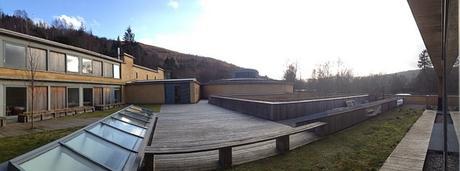 The view from a bedroom in the WISE building, home of the MSc and Part II Architecture students
The view from a bedroom in the WISE building, home of the MSc and Part II Architecture studentsThe March module of CATs Sustainability and Adaptation MSc was part B of Energy Flows in Buildings. Part A (in February) introduced us to ideas of thermal comfort and its relation to heat transfers from the human body to its surroundings. This was tied to the implications of maintaining that thermal comfort, and the impact on energy use. We learnt about calculating U-Values (used as a standard measure of the thermal efficiency of a building element), and daylighting: making best use of natural daylight in a building and calculating the resulting energy savings.
Part B expanded on this getting into more detail about limiting the flows of energy through a building, whilst addressing issues around ventilation and movement of moisture. A sustainable building should maintain a comfortable environment – comfortably warm in winter, comfortably cool in summer, ideal humidity levels, good air quality – with minimal energy input, and without moisture ingress causing degradation of the building fabric. Throughout the week different elements of possible means to achieve this were discussed.
A recurring theme throughout the week was retrofit – upgrading the thermal efficiency of existing buildings to reduce their energy use and related CO2 emissions. The most commonly stated best-estimate is that around 80% of existing houses will still be in use by 2050; the potential contribution to reduced energy use and emissions from such a large number of buildings is huge, but presents a challenge. There are advantages and disadvantages to various approaches, from aesthetic considerations (eg: changing the appearance of a building when externally insulating it), to practical (eg: loss of space when internally insulating), to technical (eg: the risk of condensation forming at the meeting of new insulation and existing structure if it is not carefully considered). Planning and conservation concerns can also influence or restrict choices for retrofit.
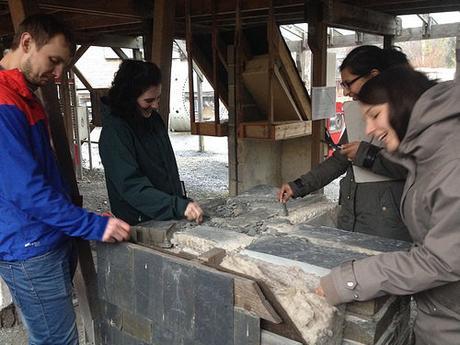 MSc students examine mockups of internal and external insulation, for solid-wall retrofit
MSc students examine mockups of internal and external insulation, for solid-wall retrofitThere are also issues and trade-offs surrounding choice of insulation materials – the most highly efficient materials may have a greater overall environmental impact than some less efficient materials. Some are more breathable (open to passage of moisture vapour) than others, which can have both positive and negative implications, depending on application.
Another recurring theme was the need to account for future changes to our climate in both retrofit and new build. In particular, too much emphasis on designing to conserve heat could lead to overheating further down the line when atmospheric temperatures increase. Careful attention to placement of glazing and shading to control solar gain can help address this, allowing direct sunlight in to provide warmth in winter when the sun’s path is lower, and sheltering the building from the most intense direct sunlight in summer when the sun is higher.
The role of thermal mass in regulating internal temperatures was discussed in a number of lectures. Depending on climate and design, thermal mass may hang on to winter day-time heat, releasing it within the building through the night – or assist cooling by absorbing excess heat in summer, if combined with effective ventilation to purge that heat at night. Used inappropriately thermal mass may add to overheating, so its use must be considered carefully.
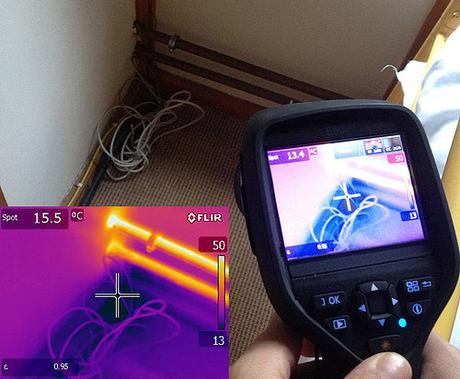 Thermal imaging shows hot heating pipes (bright) and cold area where air is coming in around cables (dark areas). There was much geeking-out while playing with the thermal imaging cameras.
Thermal imaging shows hot heating pipes (bright) and cold area where air is coming in around cables (dark areas). There was much geeking-out while playing with the thermal imaging cameras.A practical in the second half of the week provided a demonstration of heat loss through unplanned ventilation (ie: draughts). This was linked to the need to provide controlled ventilation (whether through opening windows or via mechanical ventilation), and highlighted the difficulties of achieving airtightness (eliminating draughts) in some existing buildings. The practical involved carrying out an air-pressure test to establish the air-permeability of the timber-framed selfbuild house on the CAT site (ie: how much air moved through the fabric of the building at a certain pressure). In groups we surveyed the building with thermal imaging cameras, before and during the test. The resulting images clearly showed how the cold incoming air cooled surrounding surfaces, demonstrating the impact of air infiltration on energy use. A scheme to retrofit the selfbuild house at CAT would have to include a means to reduce this.
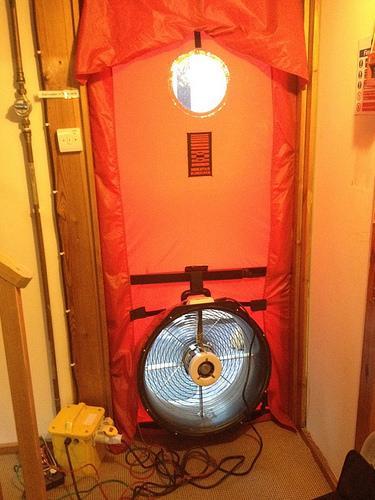 The door-fan, used to de-pressurise a building to identify air-ingress
The door-fan, used to de-pressurise a building to identify air-ingressThe end of the week saw us discussing Passivhaus and visiting the Hyddgen Passivhaus office/community building in Machynlleth, with the building’s designer John Williamson. Some myths about Passivhaus were busted (for instance: you can open windows), and the physics-based fabric-first approach was explained. The standard is based around high comfort levels combined with incredibly low energy input. While on site we investigated the MVHR unit (Mechanical Ventilation with Heat Recovery), which removes stale air from the building, and uses it to heat fresh incoming air. These are a common feature of passivhaus, as they allow the removal of moist air and other airborne contaminants and it’s replacement with fresh air, whilst minimising heat loss. This system has been the subject of some heated debates with fellow students at CAT, due to questions about the amount of energy needed to run the system and how user-friendly it is or isn’t. We were shown that when installed correctly, the system recovers more energy than is needed to run it.
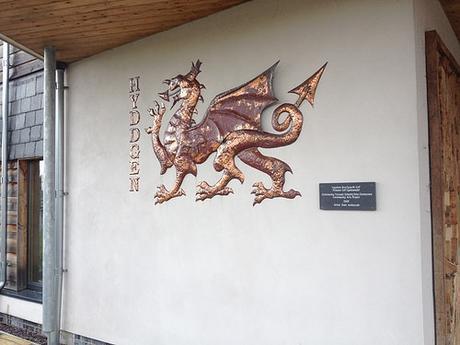 Hyddgen Passivhaus in Machynlleth
Hyddgen Passivhaus in MachynllethAs ever, throughout this course connections were constantly drawn between all the different areas covered (the inescapable interconnectedness of all things!). Nothing stands in isolation; each decision in one area can have repercussions in another. The different elements of building physics and materials must be balanced with each other and with the effect of any action on the wider environment.
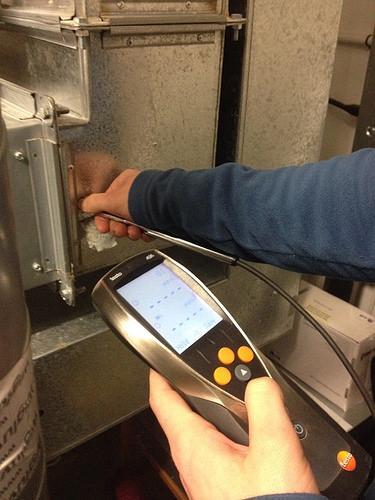 Measuring the air temperature in MVHR heating ducts at Hyddgen, prior to calculating the overall efficiency and heatloss/recovery of the the system
Measuring the air temperature in MVHR heating ducts at Hyddgen, prior to calculating the overall efficiency and heatloss/recovery of the the systemThe immersive learning environment during module weeks at CAT is highly effective, and very intense. It’s a wonderfully stimulating and supportive place to be, but at the end of the week that intensity needs a release in order for us all to return to our normal lives without winding up our friends and family when we get there. That takes the form of the vitally essential Friday night social, which this month was themed around a Cyfarfod Bach, a laid back Welsh social. We had beautiful music and singing, comedy, artwork, silliness, a rousing rendition of the Welsh National Anthem (not too shabby, considering only a handful of people were Welsh speakers or had any idea how the tune went in advance) and finally a leg-shattering amount of dancing, ensuring we could all go home in physical pain but happily and calmly buzzing.
See more blogs about the MSc Sustainability and Adaptation course.
